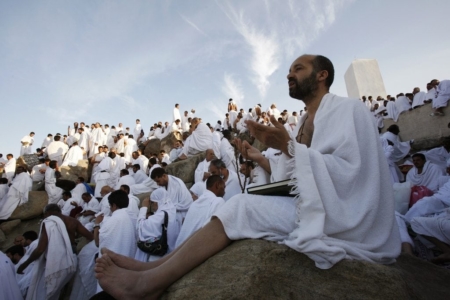Wearing Sandals on Hajj
Hanafi Fiqh
Answered by Ustadha Shaista Maqbool
Question: Wearing Sandals on Hajj
In the Name of Allah, Most Merciful, Most Kind.
Answer : The upper part of the foot (around the cuneiform bones of the foot) must be uncovered during ihram. The sandals that you wore have a strap on top of this very part of the foot, and therefore, yes, there was a violation in your ihram. Hence, you need to determine what type of expiation you owe.
The Ruling
REUTERS/Ahmed Jadallah (SAUDI ARABIA)
If a man* wore something stitched or covered his foot, or head continuously for the entire day or the entire night, or the equivalent of either of them, he must make a sacrifice. If he did so for less than this time, he must give charity. (see: Ibn Abideen, Hashiyah)
[*The rulings of clothing are specific to men as women are exempt from these considerations; The only exception is in the covering of the face, in which women are also accountable for.]
Explanation:
- “Continuously” meaning without interruption. Removing the item even momentarily e.g. for wudu, is considered an interruption.
- The “entire day” here means the Islamic day: from dawn or Fajr prayer to sunset or the Maghrib prayer; and “night” meaning from sunset/Maghrib prayer to dawn/Fajr prayer.
- “The equivalent of either of them” meaning if he had worn the item for an equivalent of either the day or night, he owes a sacrifice. So, if the day was 10 hours long and the night was 14 hours, one would have to determine whether or not he was wearing the item for 10 hours continuously, using the shorter of the two. Therefore, if he put on the item in the middle of the day or night, rather than at the beginning, he must calculate the time he was wearing it.
One should note that in most cases the continuity of the wearing is interrupted, and when there has been an interruption, the timing starts all over, ie. intervals are not added together. Therefore, in most cases charity would be obligatory, not sacrifice.
It should also be noted that unlike sacrifice, there isn’t a minimum period of time for charity, such that one must pay charity even if he wore any of these items for only a moment. Additionally, he pays charity for each “wearing” of the item, as long it is less than a day/night. For example, if he wore the item for 10 hours but would remove it each hour, he must pay 10 times of the obligatory amount of charity.
Nevertheless, in the cases where one did wear an item for more than an entire day or night, the following details should be paid attention to:
If he wore the item for more than a day or night, he still owes only one sacrifice, (i.e. he doesn’t owe 2 sacrifices for wearing it for longer than one day). The latter is also the case even if he removed the item [after having worn it continuously for a day or night] at night, for example, with an intention to wear it again during the day. However, if he removed it with the intention to discontinue wearing it, and thereafter did wear it again, he must give two sacrifices. (Hashiyah, Ibn ‘Abideen). Hence, the intention plays a major role in determining the number of sacrifices one owes.
A sacrifice is fulfilled by the slaughtering of a sheep, goat or having a share of a seventh in the sacrifice of a cow or camel. The slaughter must take place in the sacred territory in Mekkah. When one is outside Mekkah, he may authorize someone there to do the sacrifice on his behalf.
For charity, it is obligatory to give approximately 2 kg of wheat for every violation or its value in money. Charity may be given anywhere and is not restricted to the sacred territory.
And all praise if for Allah, Lord of the Worlds.

